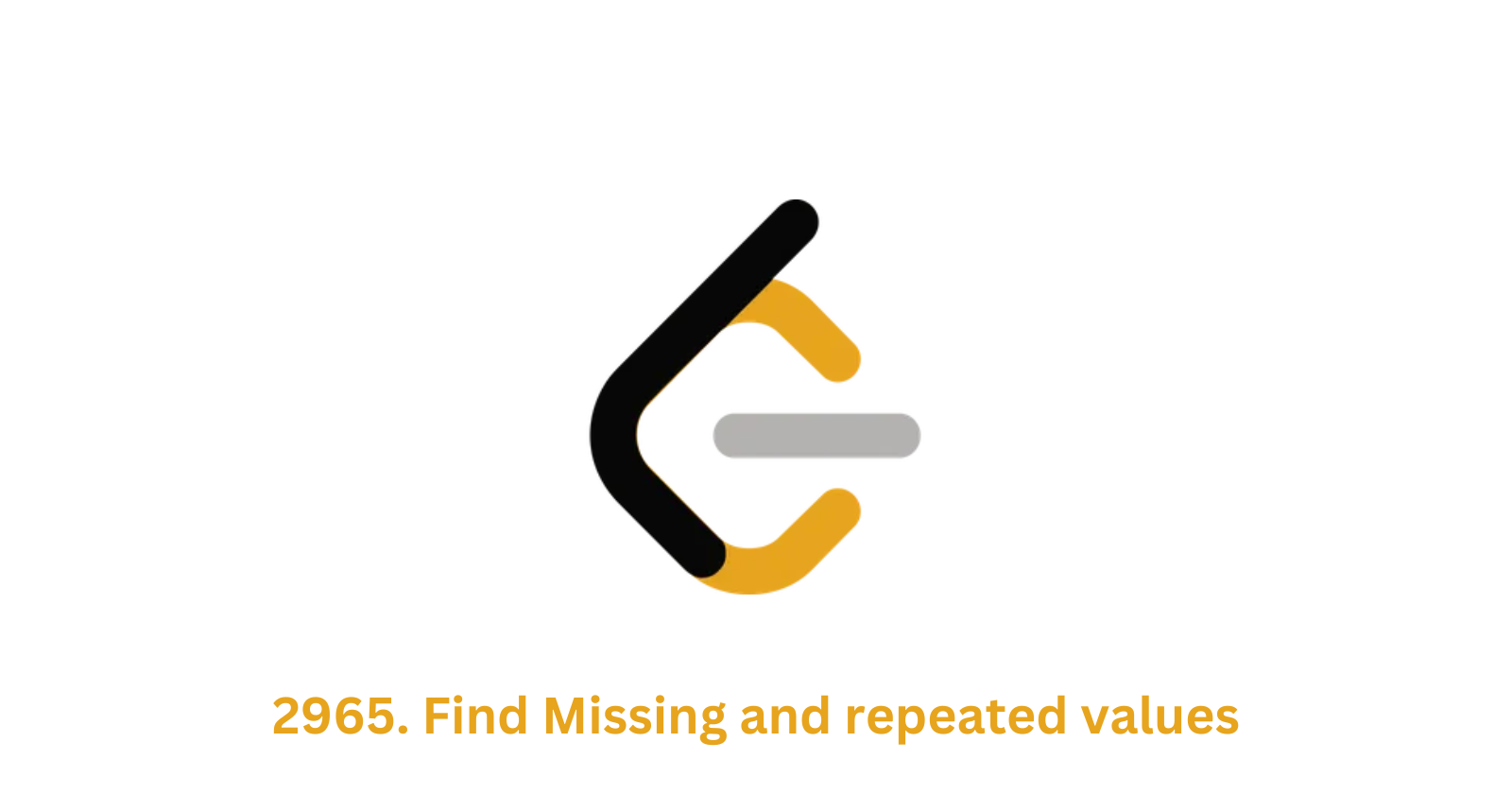2965. LeetCode: Find Missing and Repeated Values – Step-by-Step Explanation
 Darshit Anjaria
Darshit Anjaria
Finding Missing and Repeated Values
Problem Statement
The problem "Find Missing and Repeated Values" requires us to analyze a n x n grid containing numbers ranging from 1 to n^2. Each number appears exactly once, except for one number that appears twice, while another number is missing from the sequence.
Example
Input:
grid = [[1,3],[2,2]]
Output:
[2,4]
Explanation:
The number 2 is repeated, while 4 is missing. Therefore, the output is [2, 4].
Algorithm
To solve this problem, follow these steps:
Iterate through the 2D array and convert it into a 1D array.
Iterate through the 1D array and find the occurrences of each element.
Iterate through the occurrences array and determine the missing and repeated values.
Approach
To solve this problem efficiently, we break it down into two main steps:
Flatten the grid: Since the input is a 2D list, we first convert it into a 1D list for easier processing.
Identify the repeated and missing values: We count the occurrences of each number and determine which one appears twice and which one is missing.
Let's now walk through the code implementation step by step.
Code Implementation and Explanation
Step 1: Flatten the Grid
The function get_combined_array() converts a 2D grid into a 1D array.
def get_combined_array(input_arr):
combined_array = []
for mainIndex in range(len(input_arr)):
for subIndex in range(len(input_arr[mainIndex])):
combined_array.append(input_arr[mainIndex][subIndex])
return combined_array
Explanation:
We initialize an empty list
combined_arrayto store the flattened values.We iterate over the 2D list using two nested loops:
The outer loop iterates through each row.
The inner loop iterates through each element in that row.
Each value is appended to
combined_array.
Step 2: Find the Missing and Repeated Values
The function find_missing_and_repeated_values() takes the flattened array as input and identifies the repeated and missing numbers.
def find_missing_and_repeated_values(combined_array):
n = len(combined_array)
num_count = {}
for num in combined_array:
num_count[num] = num_count.get(num, 0) + 1
repeated_value = missing_value = 0
for num in range(1, n + 1):
if num_count.get(num, 0) == 2:
repeated_value = num
elif num not in num_count:
missing_value = num
return [repeated_value, missing_value]
Explanation:
We determine the length of
combined_array, which representsn^2.We create a dictionary
num_countto store the frequency of each number.We iterate through
combined_array, updating the dictionary with the count of each number.Next, we loop through the numbers from
1ton:If a number appears twice, we assign it to
repeated_value.If a number is missing, we assign it to
missing_value.
Finally, we return
[repeated_value, missing_value].
Step 3: Running the Code
The if __name__ == "__main__" block initializes the grid and executes the functions.
if __name__ == "__main__":
grid = [[9,1,7],[8,9,2],[3,4,6]]
combined_array = get_combined_array(grid)
result = find_missing_and_repeated_values(combined_array)
print(f"Final result: {result}")
Explanation:
We define a sample 2D
grid.We call
get_combined_array(grid)to flatten the 2D list into a 1D list.We call
find_missing_and_repeated_values(combined_array)to identify the missing and repeated numbers.The result is printed to the console.
Complexity Analysis
Time Complexity
Flattening the 2D array takes O(n^2).
Counting occurrences takes O(n^2).
Checking for missing/repeated values takes O(n^2).
Thus, the overall time complexity is O(n^2).
Space Complexity
combined_arraystores alln^2elements → O(n^2).num_countdictionary stores at mostn^2elements → O(n^2).Other variables take constant space → O(1).
Thus, the overall space complexity is O(n^2).
Topics Covered in This Solution
2D Array Manipulation: Converting a grid into a 1D list.
Hashing (Dictionary in Python): Counting occurrences of elements efficiently.
Iterative Approach: Using loops to process elements systematically.
This approach is simple and easy to understand, making it suitable for beginners solving similar problems involving missing and repeated numbers.
Thank You!
Thank you for reading!
I hope you enjoyed this post. If you did, please share it with your network and stay tuned for more insights on software development. I'd love to connect with you on LinkedIn or have you follow my journey on HashNode for regular updates.
Happy Coding!
Darshit Anjaria
Subscribe to my newsletter
Read articles from Darshit Anjaria directly inside your inbox. Subscribe to the newsletter, and don't miss out.
Written by

Darshit Anjaria
Darshit Anjaria
I’m a problem solver at heart, driven by the idea of building solutions that genuinely make a difference in people’s everyday lives. I’m always curious, always learning, and always looking for ways to improve the world around me through thoughtful, impactful work. Beyond building, I love giving back to the community — whether it’s by sharing what I’ve learned through blogs, tutorials, or helpful insights. My goal is simple: to make technology a little more accessible and useful for everyone. Let’s learn, build, and grow together.